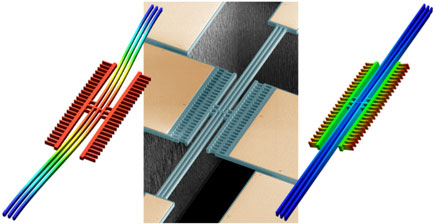| May 28, 2012 |
Frequency stabilization in nonlinear nanomechanical oscillators
|
|
(Nanowerk News) Using Center for Nanoscale Materials (CNM) expertise in the design and fabrication of micro- and nanoscale devices, a new strategy for engineering low-frequency noise oscillators capitalizes on the intrinsic nonlinear phenomena of micro- and nanomechanical resonators (see paper in Nature Communications: "Frequency stabilization in nonlinear micromechanical oscillators"). A fundamental limitation of such resonators was addressed by a team of researchers from the Nanofabrication & Devices Group working with CNICT, Argentina.
|
 |
| SEM image (center) of one resonator and finite-element simulations of the dynamic deformation characteristics of the coupled vibrational modes. The lengths of the three interconnected beams, between the comb-drive electrodes, range from 10 to 100 µm.
|
|
Mechanical oscillators are an essential component of nearly every electronic system requiring a frequency reference for timekeeping or synchronization. They are also widely used in frequency-shift-based sensors of mass, force, and magnetic field. Unfortunately, as the dimensions of vibrating semiconductor structures are reduced to the micro- and nanoscale, their dynamic response at the amplitudes needed for operation frequently becomes nonlinear.
|
|
In addition, large displacement instabilities and excessive frequency noise considerably degrade their performance. In this regime, unlike the linear case, the resonant frequency has a strong dependence with the oscillation amplitude. This increases frequency noise of the oscillator considerably, and thus, the benefits of operating at higher amplitudes are undone.
|
|
The limitation was overcome by coupling two different vibrational modes through an internal resonance, where the energy exchange between modes is such that the resonance of one mode absorbs the amplitude and frequency fluctuations of the other. This effectively acts as a stabilizing mechanical negative feedback loop.
|
|
The result demonstrates that very low-frequency noise performance is possible in the nonlinear regime and provides a path to replace quartz oscillators with nanoelectromechanical systems technology.
|

